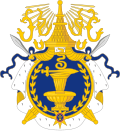This article needs additional citations for verification .(January 2017) |
| King of Cambodia | |
|---|---|
| ព្រះមហាក្សត្រនៃកម្ពុជា | |
 | |
| Incumbent | |
 | |
| Norodom Sihamoni since 29 October 2004 | |
| Details | |
| Style | His Majesty |
| First monarch | Queen Soma |
| Formation | 68 CE; 1,956–1,957 years ago |
| Abolition | 18 March 1970 – 24 September 1993 |
| Residence |
|
| Appointer | Royal Council of the Throne |
| Website | norodomsihamoni |
| This article is part of a series on the |
| Politics of Cambodia |
|---|
 |
| History of Cambodia |
|---|
| |
| Early history |
| Post-Angkor period |
| Colonial period |
| Independence and conflict |
| Peace process |
| Modern Cambodia |
| By topic |
The monarchy of Cambodia is the constitutional monarchy of the Kingdom of Cambodia. The king of Cambodia (Khmer : ព្រះមហាក្សត្រកម្ពុជា) is the head of state and head of the ruling Royal House of Norodom. In the contemporary period, the king's power has been limited to that of a symbolic figurehead. The monarchy had been in existence since at least 50 AD except during its abolition from 1970 to 1993. Since 1993, the king of Cambodia has been an elected monarch, making Cambodia one of the few elective monarchies of the world. The king is elected for life by the Royal Council of the Throne, which consists of several senior political and religious figures. Candidates are chosen from among male descendants of King Ang Duong who are at least 30 years old, from the two royal houses of Cambodia (the House of Norodom and the House of Sisowath).
Contents
- Role
- Ministry of the Royal Palace
- Mythological history
- Ancient period (68–1431)
- Funan (68–627)
- Chenla (550–802)
- Khmer Empire (802–1431)
- Middle period (1431–1863)
- Chaktomuk era (1431–1525)
- Longvek era (1525–1594)
- Srei Santhor era (1594–1620)
- Oudong era (1620–1863)
- Modern period (1863–present)
- French protectorate of Cambodia (1863–1953)
- First Kingdom of Cambodia (1953–1970)
- Second Kingdom of Cambodia (1993–present)
- Royal symbols
- See also
- Notes
- References
- External links













